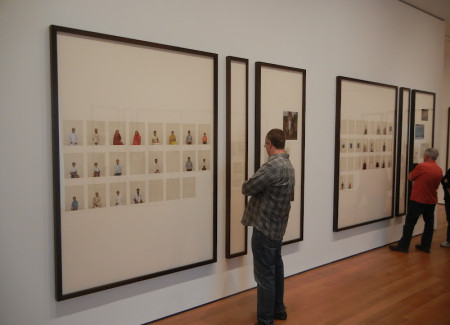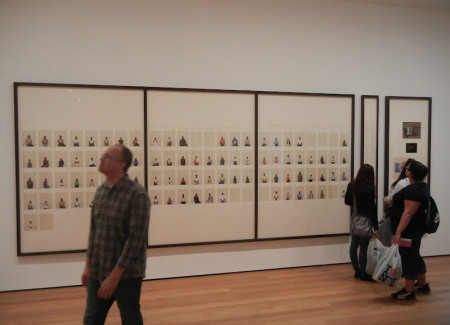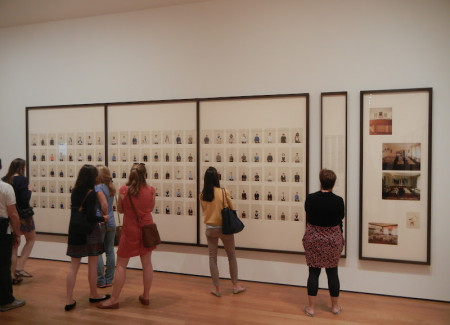JTF (just the facts): A total of 9 multi-panel mixed-media works, framed in brown wood with cream colored mounts, and hung in a divided two room gallery space on the 3rd floor of the museum. Each work is made up of three sections: an ordered group of pigmented inkjet prints displayed in 1-4 panels, a single narrow panel of explanatory text and image details, and a third panel containing other related photographs and ephemera. All of the works are dated 2011. A think monograph of this entire body of work was published in 2011 by MACK books (here) and is on display in a glass case. A newspaper style catalog is available for free in a rack outside the exhibit. As an aside, most of the works on view came from the collection of Michael and Jane Wilson. (Installation shots at right.)
Comments/Context: Taryn Simon’s newest photographic project dives deeper into the nature and definition of history than any of her previous work. It explores how photographs, text, and other documents can be used to piece together a story, providing clues and context while still leaving many questions unanswered. Her works are like exploded files from an archive, presented with an eye for order and classification, teasing out buried multi-generational narratives of struggle, violence, and survival.
From afar, Simon’s panels are totally indecipherable. Row upon row of deadpan faces (and in one case, rabbits in vitrines), strictly laid out in a genealogical tree from eldest to youngest, stare out at the viewer, devoid of recognizable context. Only after the textual background on the middle panel is read can the stories start to unfold. The people are surviors (or remains) of the Srebrenica massacre, or Ukranian orphans, or Jewish settlers, or the countless offspring of a Kenyan polygamist healer. Tied up in each of these narratives is the study of inherited consequences, of descendants being trapped by the decisions (or fate) their ancestors. An Indian man was mistakenly declared dead by the local land office, thereby throwing the ownership of the land into confusion for his entire family. A legal adviser to Hitler and a PFLP airplane hijacker permanently alter their family histories. And hundreds of Australian rabbits die testing poisonous strains of viruses used to control the exploding population, descendants from an original group of 24 introduced over 150 years earlier. It seems there is no escape from the effects of choices made long ago.
The third panel of each work is a kind of grab bag of evidence; photographs, documents, and other ephemera are offered as related facts or footnotes to the larger stories. These items and artifacts further probe the idea of how historians edit and connect, and how seemingly random pieces of information are tied together to tell a broader, more comprehensive story. In one work, Simon documents a family chosen to represent China by the State Council Information Office. Alongside these photographs and the accompanying background text, Simon has included a gift bag provided by the SCIO. It is a surprisingly resonant data point (almost ominously comic) used to reinforce just how controlled her interaction with this agency was, deftly undermining the veracity of the family story she is supposedly telling. . In these works, the documentary photographs are just one element that supports the creation of an entire narrative. And while all of the stories (constructed from both text and visuals) are presented with a kind of cohesive, scientific rigor, the structured, conceptual analysis isn’t conclusive; the patterns are there to be observed, but the process of creating the history itself is also on view. In the end, these works are an examination of the components of history, and how they are fit together to uncover and discern meaning.
Collector’s POV: Given this is a museum show, there are of course no posted prices. Taryn Simon is represented by Gagosian Gallery in New York (here) and Almine Rech Gallery in Paris and Brussels (here). Simon’s work has only recently begun to enter the secondary markets, so no definitive pricing history has yet emerged. As such, gallery retail is likely the only real option for interested collectors at this point.








